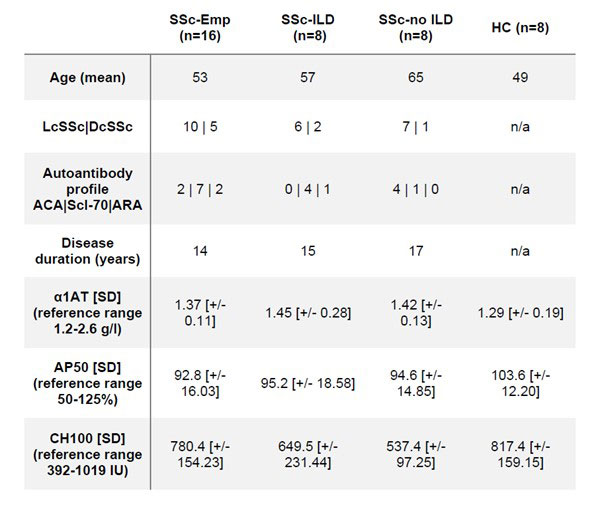Session Information
Session Type: Poster Session B
Session Time: 9:00AM-10:30AM
Background/Purpose: Aberrant complement activation is associated with autoimmune diseases including systemic sclerosis (SSc). As a leading cause of death in SSc, interstitial lung disease (ILD) can coexist with emphysema in non-smoking patients, worsening prognosis. It has been suggested that the airway destruction observed in SSc patients may be an exaggerated inflammatory response related to increased complement activation.
Methods: We analysed 10 complement proteins in plasma samples of 16 non-smoking SSc patients with emphysema (SSc-Emp), 8 SSc no-ILD, 8 SSc-ILD patients and 8 healthy controls (HC) (Table.1) selected from 1800 SSc patients under active follow up. The extent and distribution of emphysema was evaluated on high resolution computed tomography (HRCT) and enzyme-linked immunosorbent assays (ELISA) were performed for measuring C1q, MASP-2, Factor B, Factor Bb, Factor H, C3, C3a, C4, C5, C5a and TCC (terminal complement complex). One-way ANOVA and post-hoc Tukey test were used for analysis.
Results: HRCT confirmed that amongst the emphysema cohort, there was a spectrum of mild to severe destruction including both paraseptal and centrilobular emphysema. All 16 SSc-Emp patients had ILD and 9 of the 16 patients demonstrated perivascular emphysema not previously described in SSc The SSc-ILD group was characterised by extensive lung fibrosis on CT, mean FVC 71% predicted. Across the four groups, C1q was significantly reduced in the SSc-ILD cohort (SSc-Emp 950±404 µg/mL, SSc-ILD 355±116 µg/mL, SSc-no ILD 1087±206 µg/mL, HC 858±210 µg/mL, p= 0.0002). In contrast, the ratio of C3a/C3 was significantly increased in the SSc-ILD group compared with the SSc-Emp group (SSc-ILD 0.12±0.07 vs SSc-Emp 0.06±0.03, p= 0.0283). The ratio of Bb/B was significantly increased in the SSc no-ILD group compared with all other groups (SSc-Emp 1.57±0.80, SSc-ILD 1.27±0.56, SSc-no ILD 3.86±1.12, HC 1.89±0.75, p< 0.0001). There was a trend towards an increased ratio of C5a/C5 in SSc-ILD and SSc-Emp compared with HC and reduced MASP2 in the SSc groups compared with HC.
Conclusion: These data demonstrate dysregulated complement levels in three SSc subgroups. Notably, the perturbed C1q and C3a:C3 pathways in SSc-ILD are reversed in SSc-emphysema, supporting complement activation as part of the divergent tissue remodelling responses in these distinct SSc lung phenotypes.
To cite this abstract in AMA style:
Beesley C, Cole A, Goldman N, Oluwakorede O, Barnett J, Abraham D, Denton C, Mageed R, Ong V. Distinct Differences in Complement Perturbation Between Scleroderma-related Interstitial Lung Disease with and Without Emphysema [abstract]. Arthritis Rheumatol. 2022; 74 (suppl 9). https://acrabstracts.org/abstract/distinct-differences-in-complement-perturbation-between-scleroderma-related-interstitial-lung-disease-with-and-without-emphysema/. Accessed .« Back to ACR Convergence 2022
ACR Meeting Abstracts - https://acrabstracts.org/abstract/distinct-differences-in-complement-perturbation-between-scleroderma-related-interstitial-lung-disease-with-and-without-emphysema/

